Do you ever see peoples’ photos of the Northern Lights and wonder how they do it? Do you wonder just how much photo editing goes into each picture to bring out the colors and clarity. When you’re on an Alaska trip or are watching the Aurora Borealis from anywhere else, you’ll want to enjoy the experience AND walk away with a beautiful photo. Here’s how to get a great Northern Light picture.
What are the Northern Lights
The Northern Lights, also called the Aurora Borealis, are like nature’s own colorful light show in the sky when it’s really dark at night.. Imagine a big, dark canvas and then suddenly, bright colors of green, pink, and purple start dancing and twirling around, sometimes in vertical bands and sometimes moving horizontally. Your eyes might not fully process the Northern Lights when you first start to see them, but as your brain catches on they become more clear.
The Aurora Borealis happens when tiny particles from the sun, such as come from solar flares, bump into gasses in Earth’s atmosphere, paired with magnetic science things that I don’t fully understand.. When they collide, they create beautiful lights that move and change shapes, almost like magic. You can often see them in places like Alaska, Canada, and Norway, especially during the winter when it’s dark for a long time. Sometimes when the Aurora Report is really strong you can even see the Northern Lights all the way down in Florida and California.
People love to watch the Northern Lights because they’re so pretty and mysterious! It’s like the sky is putting on a special performance just for us here on earth who are staying up late. Every time I get to see the Northern Lights I am in awe, and I’ve seen then more times than I can possibly count.
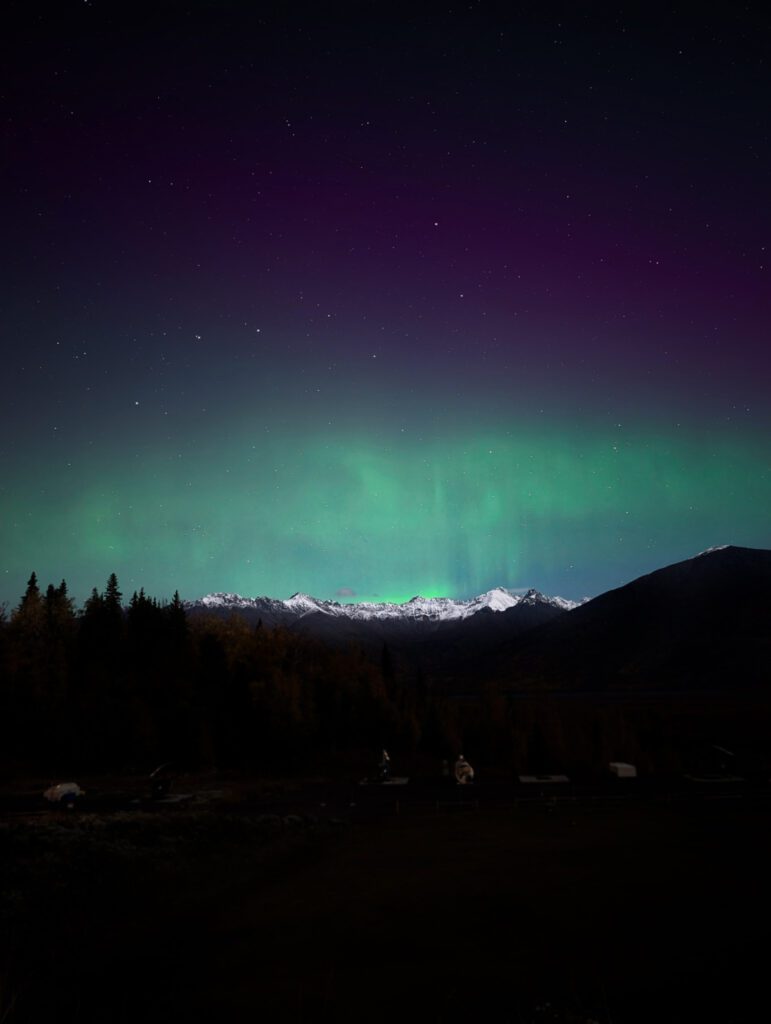
Where to See the Northern Lights
Alaska has some amazing spots to see the northern lights! I’ve seen them from the Kenai Peninsula, in Denali National Park, camping and cabining in Palmer, and even from the northside of downtown Anchorage. Here are a few of the best places if you happen to be in Alaska during a great Aurora Borealis night:
- Fairbanks: This is one of the most popular places because it’s located right under the auroral oval. There is a whole set of tourism operators that focus on Northern Lights trips. You have a good chance of seeing the lights here, especially in the winter months, due to the minimal light and perfect position on the globe.
- Denali National Park: The park offers beautiful scenery and ZERO light pollution, making it a great spot for aurora viewing. The Northern Lights tend to be easier to spot in early fall than late spring, but if you’re in the area, it’s worth trying to see them within Denali NP.
- Anchorage: While it’s a bigger city, you can still catch the northern lights if you head to darker areas nearby, like Kincaid Park or Earthquake Park. I’ve seen the light from the boat launch at the end of Ship Creek, in the parks, and even down around Turnagain Arm.
- Nome: This remote town is known for being the end of the Iditarod, its beautiful skies and is another great location for aurora viewing.
Remember, the best time to see the northern lights is during the winter months when the nights are long and dark, or at the end of summer when sunset is at 8:00 pm or earlier. The darkness paired with the solar activity are what create the best Northern Lights photos and experience.
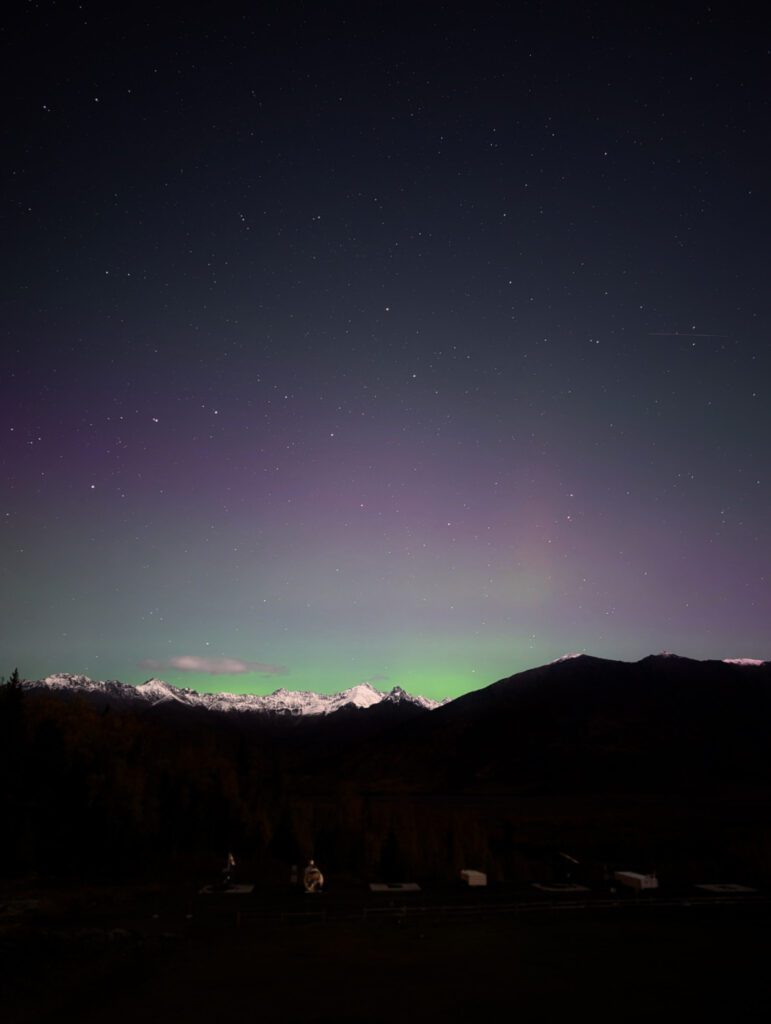
When to See the Aurora Borealis
If you’re planning a trip to see the Northern Lights in Alaska, the best times to go are during the winter months, especially from September to April. They’re visible during other times, but that’s when they’re the strongest, both for getting good Northern Lights photos and for seeing them with the naked eye. Here’s a little breakdown:
Strongest Months:
- September: The nights start getting longer, and the lights begin to appear more often. I’ve seen mostly green with a little white or pink for September Aurora Borealis nights.
- October: This is a great month because the skies are usually clear and you can see the auroras quite often. Very few people like to visit Alaska after September, so getting a good spot to watch the Light ALONE is easy. Expect good colors during October.
- November and December: These months are super good for seeing the lights since it’s dark for a long time. Plus, the lights can be really bright and colorful, and much easier to see earlier in the night.
- January: It’s still very dark, so the chances are high to catch a great show. This is when it’s the coldest, so if you’re visiting Alaska in the winter and spending time outside in the dark, you’ll need to really be well prepared for the cold. Safety first!
- February and March: These months are also excellent, with lots of clear nights and colorful displays, but again with the cold. If you’re visiting Nome or Anchorage for the Iditarod, be sure you’re staying up late to enjoy the festivities alongside the Aurora Borealis.
- April: this is the tail end of the Northern Lights season as the days are getting longer. You still have a great chance on clear nights, but as the weather warms there are more clouds and you’re less likely to see the Lights just because of cloud cover.
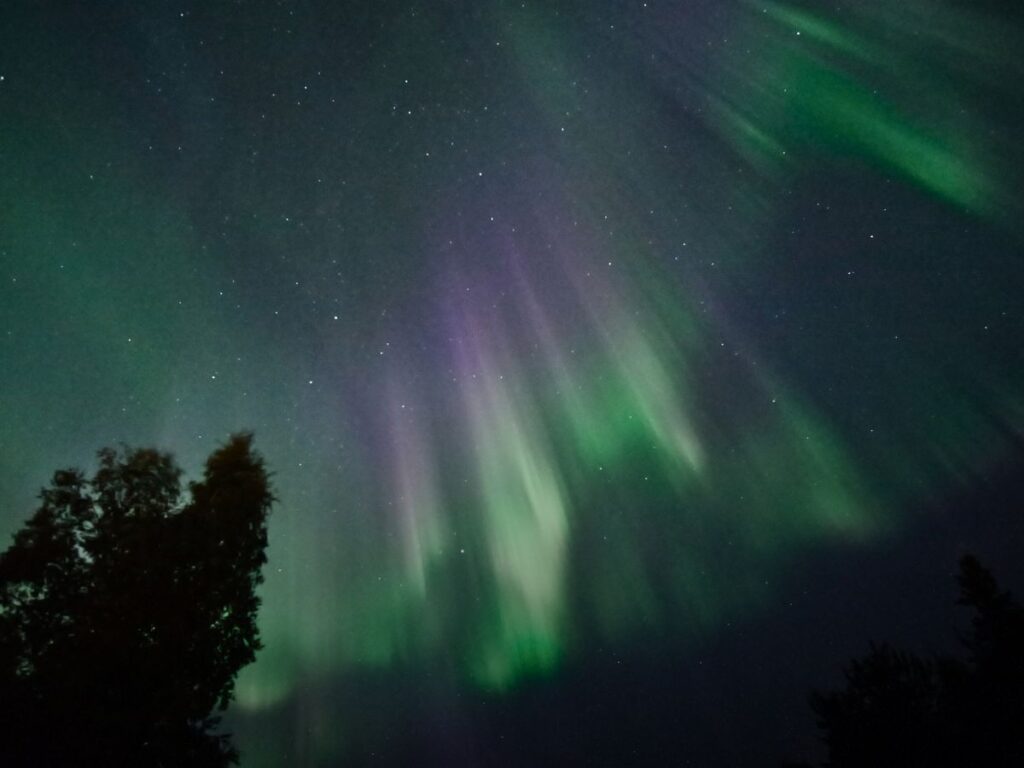
Best Times of Day to See the Northern Lights
I hate to say it, but just because it’s dark out doesn’t mean you’re going to see and get great pictures of the Northern Lights. You need solid solar activity, lack of clouds, DARKNESS and patience. The northern lights usually show up between 10 PM and 2 AM. That’s when the sky is darkest and the lights are most active due to the earth’s position.
So, if you plan your trip during these months and stay up a bit late, you might just see that amazing light show! Just remember to bundle up because it can be really cold for Northern Lights photography and viewing from September to April.
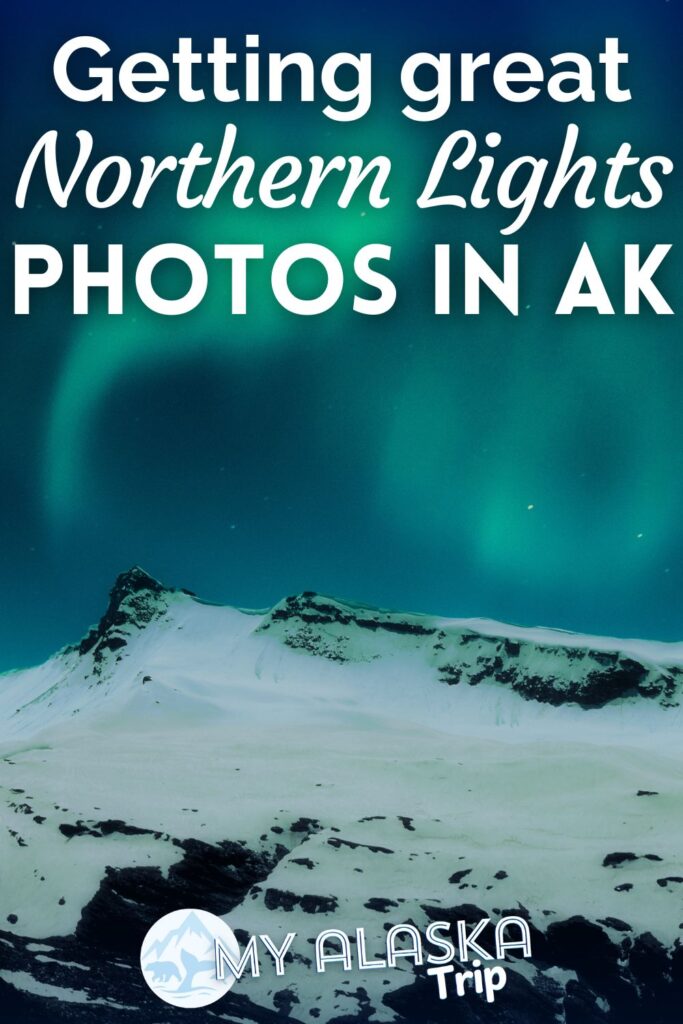
How to Get Great Northern Lights Photos
Getting good photos of the Northern Lights isn’t that complicated with today’s technology. If you have a smart phone, you’ll have no trouble capturing the Aurora Borealis. If you’re using a DSLR or mirrorless camera, it can be more complex because of the simple processing, but still wonderful. Whatever phone you’re using, be sure to set it up on a tripod of some sort so that it’s as stable as possible.
Northern Lights Pictures with a Google Pixel
The best phone for capturing good Northern Lights pictures is the Google Pixel. The Night Sight setting is the best and you’ll get a good shot very easily with a rather short exposure. The BEST photos come from putting it on Night Sight on a tripod and allowing the phone to recognize how still and dark it is. It will then engage Astrophotography mode which is amazing. Very detailed, beautiful Northern Lights photos come from the Astrophotography setting AND it will make a super short video of the motion of the sky.
The best photos are actually what you can LIFT FROM THE VIDEO. That’s right, go to the edit feature to review the short video from your Northern Lights photo and choose the frame that best captures the most clear bands of color in the sky. You can do this in the native software on a Google Pixel or within the GoPro Quik app.
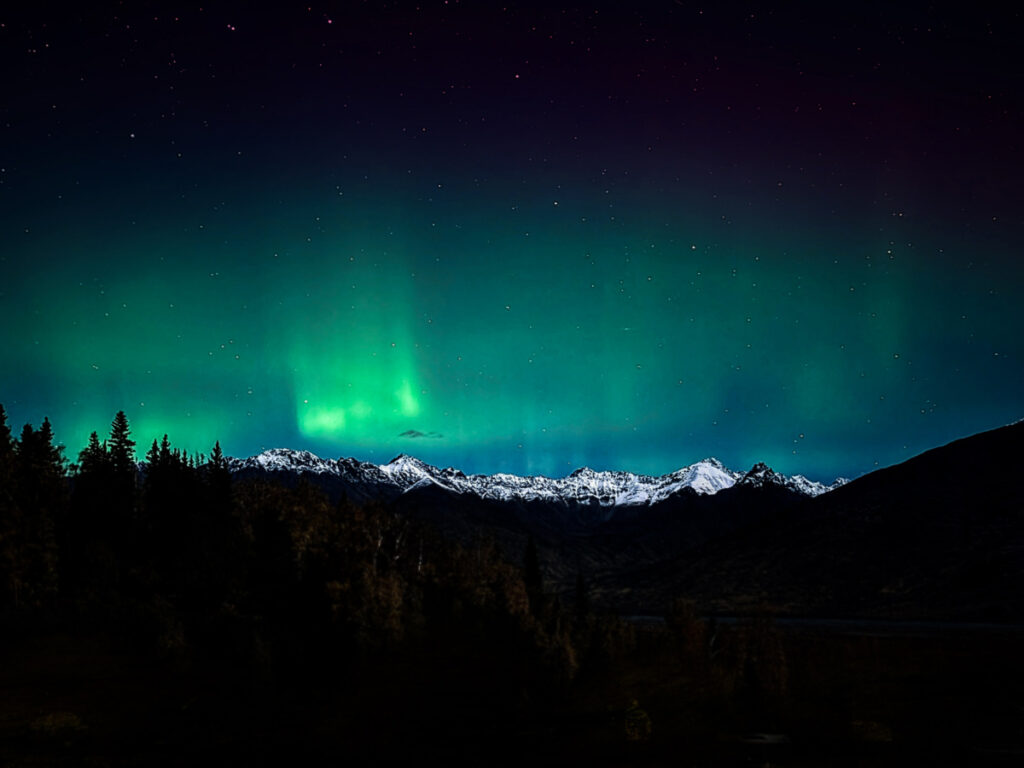
Aurora Photos with an iPhone, Samsung or Other Smartphone
Similar to using a Google Pixel, you’ll be able to capture Northern Lights pictures with any other smartphone if you have it very stable and set up for a long exposure. Unfortunately the photo software on iPhone or other smartphones isn’t as simple and pure at the Pixel’s method of capture, but you’ll still get an impressive shot.
Other Camera Suggestions for Northern Lights Photos
If you’re using a DSLR or mirrorless camera, you’ll need to set it up on a manual shot or a set duration exposure. Depending on your settings and your aperture, you may need from 10 to 30 seconds to capture a photo with a large body camera. Try the following settings to see which may get you the best MANUAL photo:
- F5.6 +- +3 ISO 800
- F4.5 +- +3 ISO 500
- F4.0 +- +3 ISO 500
You may need to change your balance or brightness up or down, but these basic settings are a good starting point.
If you’re setting up a GoPro to capture the lights, put it on Time Lapse and then swipe to the specific settings for the long exposure. When on Time Lapse, tap the “time lapse” button on the screen and select either Star Trails or Night Lapse. These will give you two different versions of light capture, with the Night Lapse being better for more crisp Northern Lights bands and colors.
Tips for Editing a Northern Lights Picture
Now that you’ve seen the Northern Lights and gotten some great photos, if you choose to edit them, I have some tips for you. I like to keep things simple, so just listen for a sec:
- Make the black of your photo stronger
- Up the saturation MINIMALLY
- Up the clarity no more than halfway to the maximum
- If you have HSL editing, up the GREEN and RED
Ultimately, you want to be able to show off the Northern Lights, but also show them as YOU saw them. Yeah, you can do cool things with editing, but focus on creating a representation of YOUR experience. I love getting to see the Northern Lights, so showcase the joy of that vs the wild side… but it’s ultimately up to you. 🙂
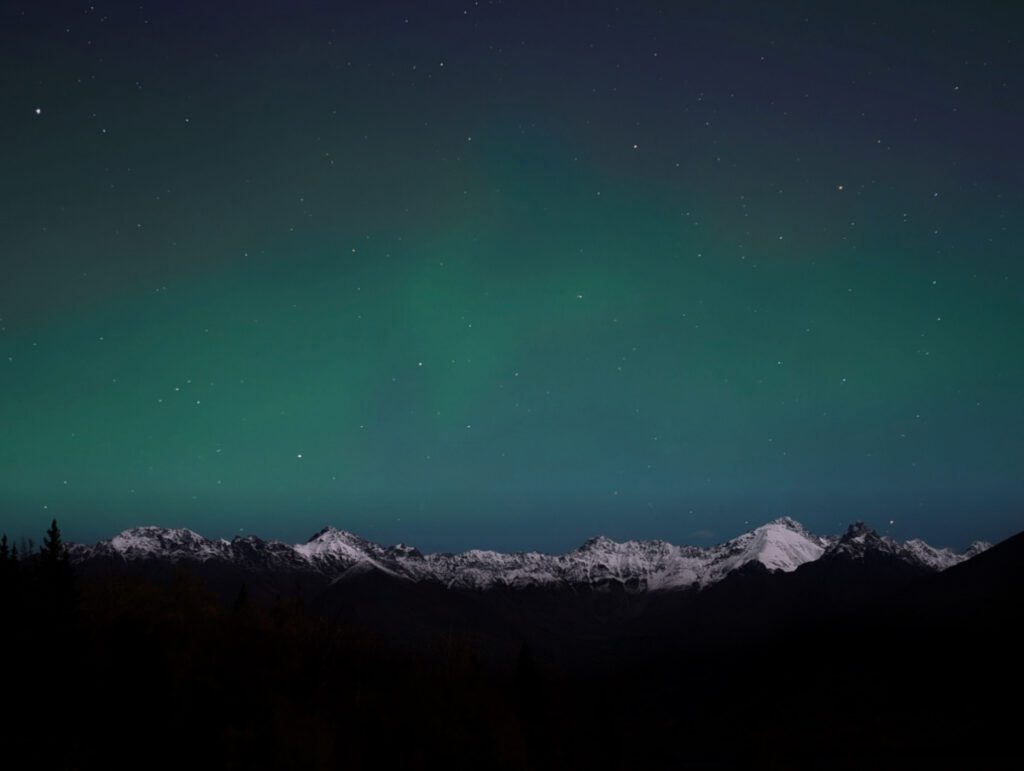
I hope you’re excited to capture great photos of the Northern Lights. They’re such a special phenomena that is a treat to share. Whether you’re here in Alaska seeing the Aurora Borealis for the first time or you’re watching the lights from a cabin in the mountains of Tennessee, enjoy the wonder and be present for the experience.
If you have any questions about photographing the Northern Lights, where to see them in Alaska, or just want to know where you can share your own photos, please leave a comment or send us a note. We’re always happy to help share the joy and wonder!
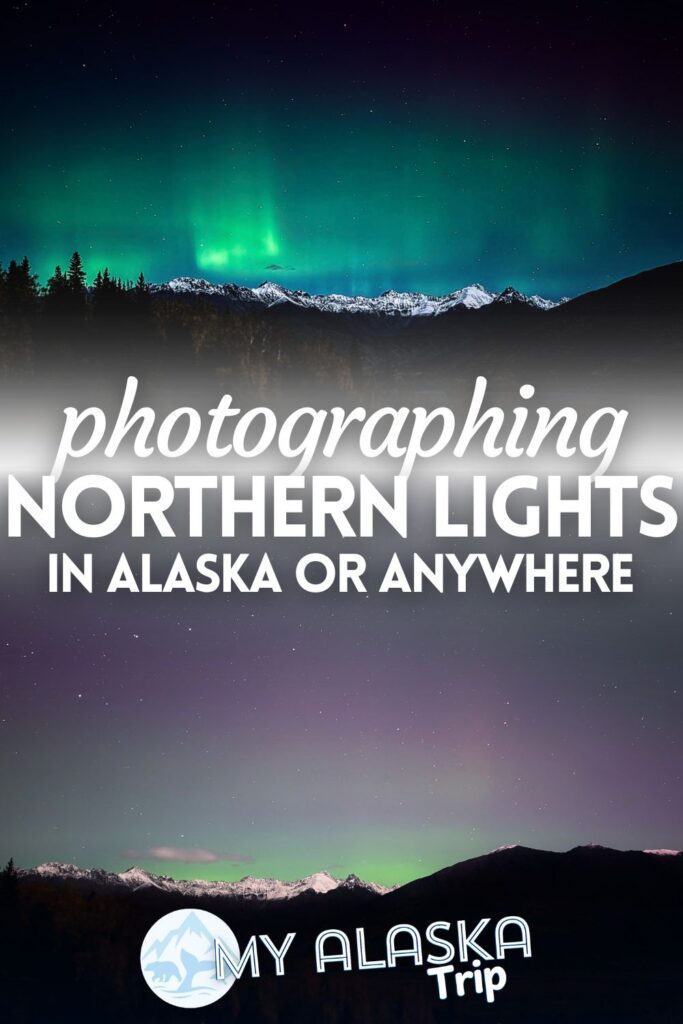

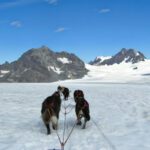
Pingback: 3 Day Palmer Itinerary: Glaciers, Hiking and Beautiful Sights
Pingback: 3 Day Talkeetna Itinerary: Beautiful Views and a Quirky Town
Pingback: 3 Day Juneau Itinerary - Beautiful Sights and Alaska Native Culture
Pingback: Alaska Trip Planning - How to Choose the Right Adventure - My Alaska Trip
Pingback: Fairbanks Winter Travel Journal: 8 Days of Ice, Aurora and Fun - My Alaska Trip
Pingback: Pike's Waterfront Lodge in Fairbanks: Vintage and Perfectly Alaska
Pingback: Aurora Pointe: Fairbanks' Awesome Northern Lights Experience
Pingback: My FAVORITE Northern Lights Experience: the Chena Aurora Tour
Pingback: The Westmark Fairbanks Hotel: Holland America's Preferred Lodge